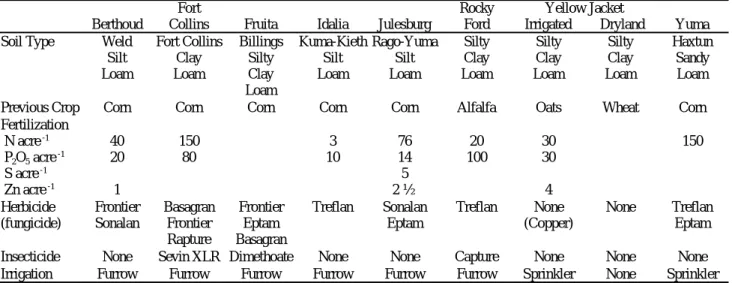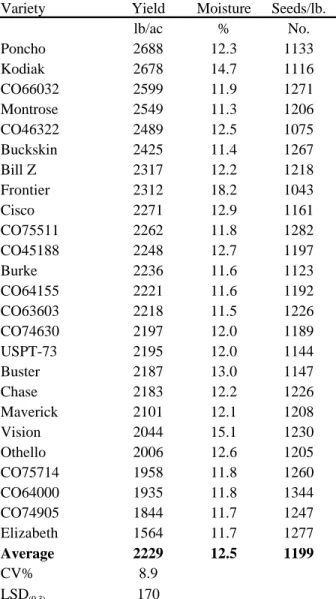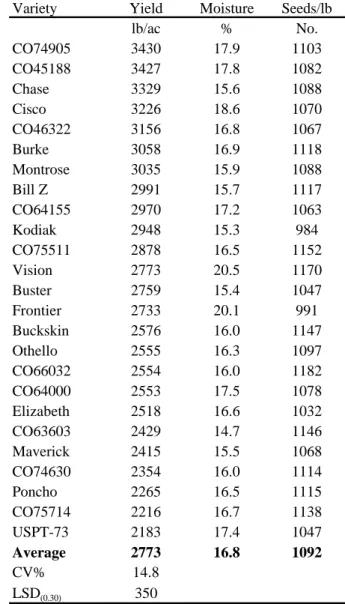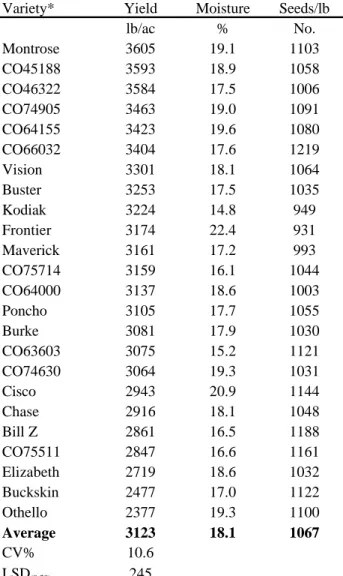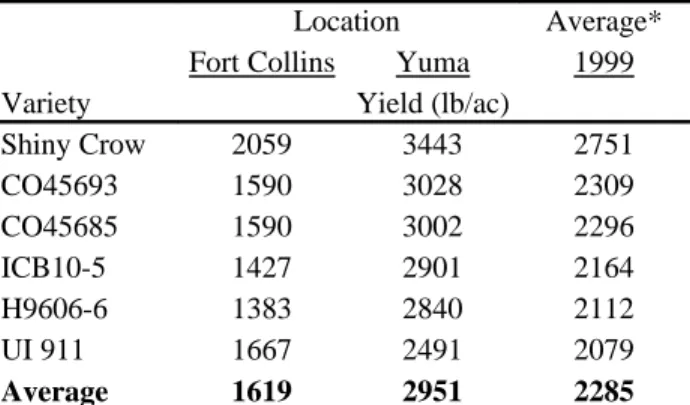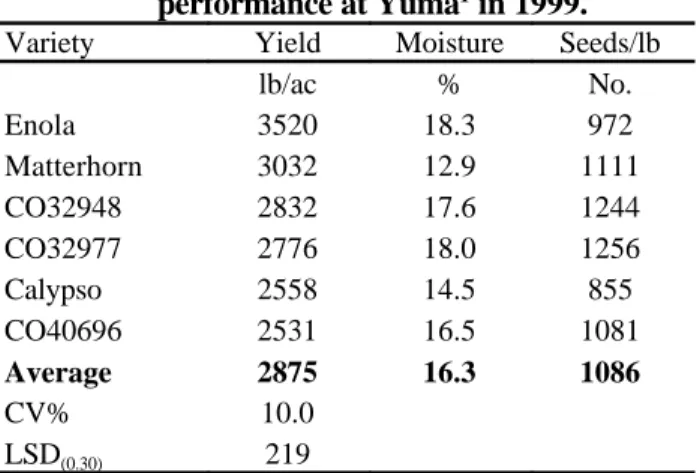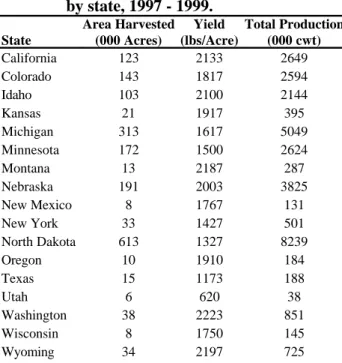Yuma Rocky Ford Yellow Jacket Fort Collins Fruita
1999 Colorado Dry Bean Test Locations Seven Pinto Bean Trial Locations and
Two Special Class Trial Locations Weld (2) 562,000 Kit Carson (3) 349,300 Yuma (1) 580,300 Phillips (4) 278,900 Sedgwick 117,000 Morgan 120,000 Montrose (5) 245,000 Dolores 155,000
1998 production (cwt) for the highest producing counties in Colorado.
Berthoud
Idalia
Julesburg KNOW YOUR DRY BEAN IMPROVEMENT TEAM
Jerry J. Johnson, Extension Specialist Crop Production (970) 491-1454
Howard F. Schwartz, Plant Pathologist, Bioagri. Sci. and Pest Mgm. (970) 491-6987 Mark A. Brick, Professor, Plant Breeding, Soil and Crop Sciences (970) 491-6551 Frank C. Schweissing, Supt., Arkansas Valley Research Center (719) 254-6312
Calvin H. Pearson, Professor, Plant Breeding, Fruita Research Center (970) 858-3629 Abdel Berrada, Research Scientist, Southwestern Research Center (970) 562-4255 Mark Stack, Manager/Research Associate, Southwestern Research Center (970) 562-4255 James P. Hain, Research Associate, Crops Testing, Soil and Crop Sciences (970) 345-2259 Cynthia L. Johnson, Research Associate, Soil and Crop Sciences (970) 491-1914
J. Barry Ogg, Research Associate, Soil and Crop Sciences (970) 491-6354 Mark McMillan, Research Associate, Bioagri. Sci. and Pest Mgm. (970) 491-7846
ACK NOWLEDG
MEN TS
The authors wish to express their gratitude to the Colorado farmers who generously contributed the use of their land, equipment, and time to conduct these trials for the benefit of all Colorado dry bean producers and bean dealers: Berthoud - Brent Adler; Idalia - Dennis Towns; Julesburg - Bruce Holcomb; Yuma - Debbie Nichols. We also acknowledge the participation of Colorado Experiment Stations at Fort Collins (Agricultural Research,
Development and Education Center); Fruita (Western Colorado Research Center); Rocky Ford (Arkansas Valley Research Center) and Yellow Jacket (Southwestern Colorado Research Center). The success of the 1999 season is due in part to efforts of Colorado Cooperative Extension agents Ron Meyer (Golden Plains), Gary Lancaster (Sedgwick County) and Jerry Alldredge (Weld County); with research support provided by The Colorado Dry Bean Administrative Committee, and publication support provided by The Colorado Bean Network.
Technical Report TR 99-10
Agricultural Department of Cooperative December
Experiment Soil and Crop Extension 1999
Station Sciences
TABLE OF CONTENTS
Introduction . . . 1
1999 Season Summary . . . 1
1999 C S U - Dry bean variety trial observations . . . 1
Dry bean variety descriptions - Summary of Test Plot Data from Eastern Colorado & Western Nebraska during 1996 - 1998 . . . 2
Dry bean trial cultural conditions in 1999 Table 1 . . . 3
Pinto bean varietal descriptions and performance trial results . . . 3
Pinto bean performance over seven Colorado sites in 1999 Table 2 . . . 4
Berthoud Table 3 . . . 5
Fruita Table 4 . . . 5
Idalia Table 5 . . . 6
Julesburg Table 6 . . . 6
Rocky Ford Table 7 . . . 7
Yellow Jacket Table 8 . . . 7
Yuma Table 9 . . . 8
Yellow Jacket (Dryland) Table 10 . . . 8
Black, light red kidney and special market class bean varietal descriptions and performance trial results in 1999 . . . 8
Black bean performance over two eastern Colorado Sites Table 11 . . . 9
Fort Collins Table 12 . . . 9
Yuma Table 13 . . . 9
Light red kidney bean performance over two eastern Colorado Sites Table 14 . . . 9
Fort Collins Table 15 . . . 10
Yuma Table 16 . . . 10
Special market class bean performance over two eastern Colorado Sites Table 17 . . . 10
Fort Collins Table 18 . . . 10
Yuma Table 19 . . . 10
Dry Bean Production Systems and Statistics in the U.S.A. . . 11
Potential Risk of Bean Diseases in Colorado by Geographical Region . . . 13
Entry Forms for 2000 Trials . . . 13
1999 COLORADO DRY BEAN PERFORMANCE TRIALS
Introduction
Colorado bean producers harvested more than 150,000 acres of dry beans in 1999 and yields are expected to average 1700 lbs/acre. Dry bean producers spend over $5 million on pinto bean seed every year, which means that the bean variety decision is extremely important. Reliable
performance results from uniform variety trials help Colorado dry bean producers make better variety decisions. With funding from the Colorado Dry Bean Administrative Committee, Colorado State University personnel evaluate dry bean varieties at multiple locations in eastern Colorado.
1999 Season Summary
1999 was the first year that the uniform variety trial was planted at Yellow Jacket and Fruita in addition to five eastern Colorado trial locations (Berthoud, Julesburg, Yuma, Idalia, and Rocky Ford). The average performance over seven
locations is a powerful tool to select varieties for the coming year. The trial serves a dual purpose of screening new CO lines emerging from CSU’s pinto bean breeding program, allowing fast and reliable selection of new lines. Other market classes were tested at Fort Collins and at the Yuma Irrigated Research Farm. A randomized complete block field design with three replicates was used in all trials. The seeding rate was approximately 87,120 seeds per acre with plots consisting of four 30-inch rows. All trials were situated in CSU or commercial bean fields. Seed yields, in pounds per acre, were adjusted to 14% moisture content.
1999 C S U - Dry bean variety trial observations Dr. H. F. Schwartz
Disease pressure was low at all test sites during 1999. Trace infections of rust and white mold were noted at a few sites late in the season. In addition, there was scattered but light infection by various bacterial diseases, especially common bacterial blight on most varieties at the northeastern sites, Julesburg and Idalia. Root rot pressure, especially from Fusarium root rot, was fairly widespread and caused light to moderate damage on varieties at Idalia and Berthoud. However, disease pressure was not uniform or severe enough to allow for a systematic varietal evaluation for disease reactions.
Berthoud:
Trace Fusarium wilt and moderate Fusarium root rot pressure throughout the nursery, with trace rust noted on susceptible varieties late in the growing season.
Idalia:
Moderate damage from herbicide drift on August 12; moderate Fusarium root rot, trace common bacterial blight, and trace rust noted on Othello and Bill Z on August 25. Julesburg:
Trace rust on Othello, Bill Z, Buckskin, Poncho, Cisco, USPT-73 on August 11 to August 25. Trace common bacterial blight infection throughout the nursery on August 25.
Rocky Ford:
Light to moderate damage from herbicide drift on July 22; moderate damage by Mexican Bean Beetle on August 5. No disease pressure.
Yuma:
Moderate herbicide carryover damage observed on July 23. No disease pressure.
DRY BEAN VARIETY DESCRIPTIONS - Summary of Test Plot Data from
Eastern Colorado & Western Nebraska during 1996 - 1998
Prepared by Drs. H.F. Schwartz, J.J. Johnson & M.A. Brick - Colorado State University (9/99)
Growth 1996-98 Summary from CO + NE Data4
Seed Quality Observation5
Variety Origin/Year1 Habit2 Maturity3 Yield - lb/A Seed/lb # Test Sites Disease Resistance6 Pinto’s
Apache ISB-96 V M 2224 1242 50 ** BC1 / BC2 / CT / RU
Bill Z CSU-87 V F 2260 1350 50 * BC1 / BC2
Buckskin Novartis-94 V F 2539 1272 12 BC1 / BC2 / CT / HB / BBS
Burke
(USWA 19) USDA-98 SU/V F 2323 1246 16 BC1/ BC2 / CT /RU / HB
Chase UN-93 V F 2508 1312 50 ** RU / WM / HB / BBS Elizabeth Fox - 97 V F 2325 1251 12 ** RU Frontier NDSU-97 SU L 2582 1246 5 BC1 / BC2 / RU / WM GTS 900 Gentec-98 V L 2322 1297 11 BC1 / BC2 / RU / WM Hatton NDSU-95 V F 2195 1216 8 BC1 / BC2 Maverick NDSU-95 SU F 2330 1314 12 RU Montrose (CO51715) CSU-98 V F 2761 1229 9 * BC1 / BC2 / CT / RU Othello USDA-86 SU M 2666 1268 6 * BC1 / BC2 / CT Poncho (ROG 179) Novartis-98 V L 2427 1263 46 * BC1 / BC2 / RU / HB / BBS Vision Semanis-96 U F 2319 1321 50 * RU / FR Winchester Novartis-95 V F 2660 1369 6 Kidney Types
Enola (yellow) Proctor-98 B F 1948 1112 3 RU / WM
CE-LRK UC-89 B M 2157 777 4 BC1 / BC2 / RU / WM
Foxfire Novartis-92 B F 2682 938 2 BC1 / RU / WM / CB / HB
Sacramento UC-75 B M 2368 818 3 RU / WM
Black’s
Black Jack Gentec-93 B L 1746 2427 2 WM / FR / HB
Midnight SUNY-80 U L 2331 2490 3 BC1 / BC2 / FR / PY Shadow Novartis-95 U L 2469 2064 5 BC1 / BC2 / RU Shiny Crow (CO96902) CSU-00 V F 2443 2134 4 BC1 / BC2 UI 911 UI-93 U F 2003 2555 3 BC1 / BC2 Great Northern’s Beryl Novartis-84 V F 2689 1602 3 BC1 / BC2 / CT / CB Harris UN-80 V F 2522 1312 3 BC1 / BC2 / BY / CB / HB Ivory Novartis-83 V M 2345 1265 3 BC1 / BC2 / CT / HB Marquis Novartis-92 V F 2922 1518 3 BC1 / BC2 / WM / CB / HB UI 425 UI-84 V F 2728 1376 4 BC1 / BC2 / CT Weihing (GN 94-9) UN-98 V L 2528 1366 5 RU / CB
! Note 1: CSU = Colorado State University, Fox = Fox Bean of Idaho, Gentec = Gentec Seeds of Canada, ISB = Idaho Seed Beans, NDSU = North Dakota State University, Novartis = Novartis Seeds of Idaho, Proctor = Red Beard Bean of Colorado, Seminis = Seminis Seeds of Idaho, SUNY = Cornell University of New York, UC = Univ. of California at Davis, UI = Univ. of Idaho, UN = Univ. of Nebraska, USDA = USDA of Prosser Idaho
! Note 2: Growth Habit = V (vine), SU (semiupright), U = (upright), B = (bush). Suggested plant populations: V = 75 -80000, SU = 80 - 85000, U = 85 - 90000, B = 90 - 100000 / acre. Adjust fertility levels in relation to adjusted plant populations for each growth habit; for example, a common suggestion for low fertility soils for vine growth habits at 75000 plants is 75 lb N + 40 lb P / Acre.
90-94 days), F (Full Season, 95-99 days), L (Late, 100 or more days)
! Note 4: Yield data summarized from published reports of Colorado Variety Trials (CSU - J. Johnson), Nebraska Variety Trials (UN - D. Nuland) and Nebraska Farm Trials (D. Nuland & R. Zeller); these yields are conservative estimates of varietal potential since moderate plant populations were used uniformly for each trial, regardless of varying growth habits. ! Note 5: Seed Quality observations from dry bean industry and/or university personnel reflect the general appearance of
seed of varieties that is generally light enough for most markets (*) or which may exhibit premature darkening and/or yellowing (**) within the 1st year after harvest.
! Note 6: Disease Resistance as defined by the variety release statement, and may range from immunity to tolerance to disease avoidance in our region: BBS = Bacterial Brown Spot, BC1 = Bean Common Mosaic Virus - NY Strain, BC2 = Bean Common Mosaic Virus - Type Strain, BY = Bean Yellow Mosaic Virus - Pea Strain, CB = Common Bacterial Blight, CT = Curly Top Virus, HB = Halo Blight, FR = Fusarium Root Rot, PY = Pythium, RU = Rust, WM = White Mold
Table 1. Dry bean trial cultural conditions in 1999.
Berthoud
Fort
Collins Fruita Idalia Julesburg
Rocky Ford
Yellow Jacket
Irrigated Dryland Yuma Soil Type Weld
Silt Loam Fort Collins Clay Loam Billings Silty Clay Loam Kuma-Kieth Silt Loam Rago-Yuma Silt Loam Silty Clay Loam Silty Clay Loam Silty Clay Loam Haxtun Sandy Loam
Previous Crop Corn Corn Corn Corn Corn Alfalfa Oats Wheat Corn
Fertilization N acre -1 P2O5 acre -1 S acre -1 Zn acre -1 40 20 1 150 80 3 10 76 14 5 2 ½ 20 100 30 30 4 150 Herbicide (fungicide) Frontier Sonalan Basagran Frontier Rapture Frontier Eptam Basagran Treflan Sonalan Eptam Treflan None (Copper) None Treflan Eptam
Insecticide None Sevin XLR Dimethoate None None Capture None None None
Irrigation Furrow Furrow Furrow Furrow Furrow Furrow Sprinkler None Sprinkler
Pinto bean varietal descriptions:
Bill Z A variety release by Colorado State University in 1985. It has a vine Type III growth habit with resistance to bean common mosaic virus and moderate tolerance to bacterial brown spot. It is a productive variety when growing conditions are good, susceptible to white mold and rust, and medium maturity.
Buckskin A Type III variety from Novartis Seeds, Inc.
Burke A medium season variety (USWA-19) released by Washington State in 1996. It has resistance to rust. Buster A new variety from Asgrow Seed
Co. (5051) released in 1999. Chase A variety released by the University
of Nebraska. It is resistant to rust and white mold, moderately resistant
to bacterial brown spot, but
moderately susceptible to Fusarium wilt.
CO45188 An experimental line from Colorado State University with resistance to rust.
CO46322 An experimental line from Colorado State University with resistance to rust.
CO63603 An experimental line from Colorado State University with resistance to rust.
CO64000 An experimental line from Colorado State University with resistance to rust.
CO64155 An experimental line from Colorado State University with resistance to rust.
CO66032 An experimental line from Colorado State University with resistance to
rust.
CO74630 An experimental line from Colorado State University with resistance to rust.
CO74905 An experimental line from Colorado State University with resistance to rust.
CO75511 An experimental line from Colorado State University with resistance to rust.
CO75714 An experimental line from Colorado State University with resistance to rust.
Cisco A variety from Novartis Seeds Inc. (RNK 354).
Elizabeth A variety from Fox Bean Co. with rust resistance.
Frontier A variety from North Dakota State University.
Kodiak A variety from Michigan (P94207) with rust resistance.
Maverick An upright variety that is resistant to rust, released by North Dakota State University.
Montrose A variety released from Colorado State University in 1999 (CO51715) with resistance to rust and excellent seed quality.
Othello A variety released by the USDA with a semi-upright growth habit. It is highly susceptible to rust and bacterial diseases.
Poncho A variety from Novartis Seeds, Inc. (ROG 179) susceptible to rust, but moderately resistant to some bacterial diseases.
USPT-73 An experimental line from USDA-ARS, Prosser, WA.
Vision A full season upright variety with resistance to rust released by Asgrow Seed Co.
Table 2. Average pinto bean performance over seven Colorado sites in 1999.
Location Average
Berthoud Fruita Idalia Julesburg Rocky Ford Yellow Jacket Yuma 1999
Variety* Yield (lb/ac)
CO45188 2248 2795 2109 3427 3575 2634 3593 2912 Montrose 2549 2988 2293 3035 3324 1953 3605 2821 Cisco 2271 3189 2396 3226 3425 1978 2943 2775 CO74905 1844 2919 2337 3430 3149 1982 3463 2732 CO46322 2489 2372 2313 3156 3207 1899 3584 2717 CO64155 2221 2985 2118 2970 3167 2070 3423 2708
Buster 2187 3360 2319 2759 2518 2307 3253 2672 CO75511 2262 2915 2220 2878 2832 2462 2847 2631 Bill Z 2317 2754 2108 2991 3201 2084 2861 2617 Poncho 2688 2988 1876 2265 3340 2031 3105 2613 Vision 2044 2996 1841 2773 2951 2327 3301 2604 Chase 2183 2392 2208 3329 2651 2412 2916 2584 CO66032 2599 2613 1924 2554 3083 1873 3404 2579 Kodiak 2678 2863 2061 2948 2337 1686 3224 2542 Frontier 2312 2594 2012 2733 3524 1442 3174 2542 Buckskin 2425 2820 2119 2576 2750 2156 2477 2475 Burke 2236 2486 1644 3058 2365 2375 3081 2464 CO63603 2218 2668 2083 2429 2700 1876 3075 2436 Maverick 2101 2632 2044 2415 2463 2220 3161 2434 USPT-73** 2195 3274 2229 2183 1967 2662 --- 2418 CO74630 2197 2907 1753 2354 2692 1908 3064 2411 CO75714 1958 2958 1806 2216 2615 2058 3159 2396 CO64000 1935 3260 2129 2553 916 2438 3137 2338 Othello 2006 2764 1970 2555 1828 2354 2377 2265 Elizabeth 1564 2432 2016 2518 2144 1852 2719 2178 Average 2229 2837 2077 2773 2749 2122 3123 2559
*Varieties ranked by the average yield over seven locations in 1999. **Average over six locations only due to insufficient data at Yuma.
Table 3. Pinto bean performance at Berthoud1
in 1999.
Variety Yield Moisture Seeds/lb.
lb/ac % No. Poncho 2688 12.3 1133 Kodiak 2678 14.7 1116 CO66032 2599 11.9 1271 Montrose 2549 11.3 1206 CO46322 2489 12.5 1075 Buckskin 2425 11.4 1267 Bill Z 2317 12.2 1218 Frontier 2312 18.2 1043 Cisco 2271 12.9 1161 CO75511 2262 11.8 1282 CO45188 2248 12.7 1197 Burke 2236 11.6 1123 CO64155 2221 11.6 1192 CO63603 2218 11.5 1226 CO74630 2197 12.0 1189 USPT-73 2195 12.0 1144 Buster 2187 13.0 1147 Chase 2183 12.2 1226 Maverick 2101 12.1 1208 Vision 2044 15.1 1230 Othello 2006 12.6 1205 CO75714 1958 11.8 1260 CO64000 1935 11.8 1344 CO74905 1844 11.7 1247 Elizabeth 1564 11.7 1277 Average 2229 12.5 1199 CV% 8.9 LSD(0.3) 170
1Trial conducted on the Brent Adler farm; seeded 6/7 and harvested 9/24.
Table 4. Pinto bean performance at Fruita1 in
1999.
Variety Yield Seeds/lb.
lb/ac No. Buster 3360 1241 USPT-73 3274 1040 CO64000 3260 1101 Cisco 3189 1126 Vision 2995 1220 Montrose 2989 1176 Poncho 2988 1116 CO64155 2985 1118 CO75714 2957 1182 CO74905 2919 1198 CO75511 2914 1211 CO74630 2907 1055 Kodiak 2863 1226 Buckskin 2820 1184 CO45188 2795 1167 Othello 2764 1135 Bill Z 2754 1231 CO63603 2668 1155 Maverick 2632 1205 CO66032 2613 1244 Frontier 2594 1082 Burke 2486 1111 Elizabeth 2432 1146 Chase 2392 1270 CO46322 2372 1101 Average 2837 1162 CV% 9.4 LSD(0.30) 229
1Trial conducted on the Western Colorado Research Center; seeded 6/21 and harvested 10/4.
Table 5. Pinto bean performance at Idalia1 in
1999.
Variety Yield Moisture Seeds/lb
lb/ac % No. Cisco 2396 16.0 1167 CO74905 2337 11.8 1297 Buster 2319 15.0 1140 CO46322 2313 16.9 1150 Montrose 2293 13.6 1138 USPT-73 2229 13.6 1058 CO75511 2220 14.5 1320 Chase 2208 17.0 1220 CO64000 2129 14.1 1200 Buckskin 2119 14.9 1223 CO64155 2118 15.3 1117 CO45188 2109 17.1 1205 Bill Z 2108 14.5 1265 CO63603 2083 14.0 1200 Kodiak 2061 17.1 1088 Maverick 2044 15.0 1180 Elizabeth 2016 15.4 1120 Frontier 2012 16.7 1155 Othello 1970 13.0 1188 CO66032 1924 12.8 1245 Poncho 1876 15.9 1133 Vision 1841 18.7 1403 CO75714 1806 18.1 1312 CO74630 1753 13.9 1108 Burke 1644 16.3 1144 Average 2077 15.2 1191 CV% 9.1 LSD(0.3) 162
1Trial conducted on the Dennis Towns farm; seeded 5/27 and harvested 9/6.
Table 6. Pinto bean performance at Julesburg1
in 1999.
Variety Yield Moisture Seeds/lb
lb/ac % No. CO74905 3430 17.9 1103 CO45188 3427 17.8 1082 Chase 3329 15.6 1088 Cisco 3226 18.6 1070 CO46322 3156 16.8 1067 Burke 3058 16.9 1118 Montrose 3035 15.9 1088 Bill Z 2991 15.7 1117 CO64155 2970 17.2 1063 Kodiak 2948 15.3 984 CO75511 2878 16.5 1152 Vision 2773 20.5 1170 Buster 2759 15.4 1047 Frontier 2733 20.1 991 Buckskin 2576 16.0 1147 Othello 2555 16.3 1097 CO66032 2554 16.0 1182 CO64000 2553 17.5 1078 Elizabeth 2518 16.6 1032 CO63603 2429 14.7 1146 Maverick 2415 15.5 1068 CO74630 2354 16.0 1114 Poncho 2265 16.5 1115 CO75714 2216 16.7 1138 USPT-73 2183 17.4 1047 Average 2773 16.8 1092 CV% 14.8 LSD(0.30) 350
1Trial conducted on the Bruce Holcomb farm; seeded 6/9 and harvested 10/6.
Table 7. Pinto bean performance at Rocky Ford1 in 1999.
Variety Yield Moisture Seed/lb
lb/ac % No. CO45188 3575 12.6 1132 Frontier 3524 16.9 958 Cisco 3425 13.1 1102 Poncho 3340 11.8 1076 Montrose 3324 12.1 1146 CO46322 3207 12.1 1061 Bill Z 3201 11.9 1148 CO64155 3167 12.5 1137 CO74905 3149 12.0 1147 CO66032 3083 11.2 1223 Vision 2951 15.1 1179 CO75511 2832 11.0 1214 Buckskin 2750 11.5 1166 CO63603 2700 11.0 1150 CO74630 2692 12.4 1103 Chase 2651 12.4 1130 CO75714 2615 12.4 1215 Buster 2518 11.4 1062 Maverick 2463 11.2 1117 Burke 2365 11.1 1191 Kodiak 2337 11.5 1020 Elizabeth 2144 12.0 1133 USPT-73 1967 12.2 1053 Othello 1828 12.3 1147 CO64000* 916 13.6 1239 Average 2749 12.3 1130 CV% 8.7 LSD(0.3) 205
1Trial conducted on the Arkansas Valley Research Center; seeded 5/21 and harvested 9/30.
*Mexican Bean Beetle Damage.
Table 8. Irrigated pinto bean performance at Yellow Jacket1 in 1999.
Variety Yield Seed/lb
lb/ac No. USPT-73 2662 1270 CO45188 2634 1582 CO75511 2462 1467 CO64000 2438 1350 Chase 2412 1518 Burke 2375 1329 Othello 2354 1331 Vision 2327 1356 Buster 2307 1402 Maverick 2220 1341 Buckskin 2156 1465 Bill Z 2084 1563 CO64155 2070 1387 CO75714 2058 1618 Poncho 2031 1387 CO74905 1982 1491 Cisco 1978 1483 Montrose 1953 1535 CO74630 1908 1458 CO46322 1899 1535 CO63603 1876 1523 CO66032 1873 1628 Elizabeth 1852 1442 Kodiak 1686 1362 Frontier 1442 1325 Average 2122 1446 CV% 15.2 LSD(0.30) 276
1Trial conducted on the Southwestern Colorado Research Center; seeded 6/11 and harvested 9/29.
Table 9. Pinto bean performance at Yuma1 in
1999.
Variety* Yield Moisture Seeds/lb
lb/ac % No. Montrose 3605 19.1 1103 CO45188 3593 18.9 1058 CO46322 3584 17.5 1006 CO74905 3463 19.0 1091 CO64155 3423 19.6 1080 CO66032 3404 17.6 1219 Vision 3301 18.1 1064 Buster 3253 17.5 1035 Kodiak 3224 14.8 949 Frontier 3174 22.4 931 Maverick 3161 17.2 993 CO75714 3159 16.1 1044 CO64000 3137 18.6 1003 Poncho 3105 17.7 1055 Burke 3081 17.9 1030 CO63603 3075 15.2 1121 CO74630 3064 19.3 1031 Cisco 2943 20.9 1144 Chase 2916 18.1 1048 Bill Z 2861 16.5 1188 CO75511 2847 16.6 1161 Elizabeth 2719 18.6 1032 Buckskin 2477 17.0 1122 Othello 2377 19.3 1100 Average 3123 18.1 1067 CV% 10.6 LSD(0.30) 245
1Trial conducted on the Irrigation Research Farm; seeded 6/17 and harvested 10/11.
*Variety USPT-73 was not reported due to insufficient data.
Table 10. Dryland Pinto Bean Variety Trial at Yellow Jacket1 in 1999.
Variety Yield Maturity2
lb/ac Cahone 1454 Sept.13 89721* 1416 +3-5 days 78158* 1377 +3-5 days 90432-2-10* 1324 +3-7 days Fisher* 1300 +3-5 days 90436-2-2* 1272 +3-5 days 90436-2-3* 1251 +3-5 days 28141-33* 1246 +3-5 days 28140-3* 1237 +3-5 days 90432-2-8* 1209 +3-5 days 28140-8* 1171 +3-5 days 10152-2-2* 1109 +3-5 days Average 1281 CV% 4.3 LSD(0.05) 79
1Trial conducted on the Southwestern Colorado Research Center; seeded 6/12 and harvested 9/22.
2Maturity relative to Cahone.
*Experimental lines from Colorado State University.
Black, light red kidney and special market class bean varietal descriptions:
Calypso A black and white seeded novelty variety.
Chardonnay A light red kidney line from Asgrow Seed Co (B340).
CO32948 An experimental black seeded line from Colorado State University. CO32977 An experimental black seeded line
from Colorado State University. CO40696 An experimental black seeded line
from Colorado State University. CO45685 An experimental black seeded line
from Colorado State University. CO45693 An experimental black seeded line
from Colorado State University. Enola A yellow seeded variety from Red
Beard Bean Co., Delta, CO. Foxfire A light red kidney line from
Novartis Seeds, Inc.
H9606-6 An experimental black seeded line from the USDA-ARS Prosser, WA. H9666-9 An experimental light red kidney
line from the USDA-ARS Prosser, WA.
USDA-ARS Prosser, WA.
Matterhorn A great northern variety released by Michigan State University in 1998. ROG 728 A light red kidney line from
Novartis Seeds, Inc.
Sacramento A light red kidney variety from Sacramento Valley Milling. Shiny Crow A shiny black seeded line from
Colorado State University (CO96902), scheduled for release
in 2000 for seed and in 2001-20002 for commercial production.
UI 911 A black seeded variety from University of Idaho. It has high yields, an upright growth habit, and resistance to BCMV seed.
USLK-1 A light red kidney line from Washington State University.
Table 11. Average black bean performance over two eastern Colorado sites in 1999.
Location Average* Fort Collins Yuma 1999
Variety Yield (lb/ac)
Shiny Crow 2059 3443 2751 CO45693 1590 3028 2309 CO45685 1590 3002 2296 ICB10-5 1427 2901 2164 H9606-6 1383 2840 2112 UI 911 1667 2491 2079 Average 1619 2951 2285
*Varieties ranked by the average yield over two locations in 1999.
Table 12. Black bean performance at Fort Collins1 in 1999.
Variety Yield Seeds/lb
lb/ac No. Shiny Crow 2059 2272 UI 911 1667 2336 CO45693 1590 2375 CO45685 1590 2113 ICB10-5 1427 2261 H9606-6 1383 2077 Average 1619 2239 CV% 11.2 LSD(0.30) 162 1
Trial conducted on the Agricultural Research Development and Education Center; seeded 5/31 and harvested 10/11.
Table 13. Black bean performance at Yuma1 in
1999.
Variety Yield Moisture Seeds/lb
lb/ac % No. Shiny Crow 3443 18.2 1832 CO45693 3028 13.6 1814 CO45685 3002 14.0 1798 ICB10-5 2901 17.4 1731 H9606-6 2840 15.0 1815 UI 911 2491 14.2 1899 Average 2951 15.4 1815 CV% 9.4 LSD(0.30) 210
1Trial conducted on the Irrigation Research Farm; seeded 6/17 and harvested 10/12.
Table 14. Average light red kidney bean performance over two eastern Colorado sites in 1999.
Location Average* Fort Collins Yuma 1999
Variety Yield (lb/ac)
ROG 728 1438 3455 2447 H9666-9 1874 2638 2256 Foxfire 1296 2850 2073 Sacramento LRK 610 2667 1638 USLK-1 741 2221 1481 Chardonnay 523 2133 1328 Average 1080 2661 1870
*Varieties ranked by the average yield over two locations in 1999.
Table 15. Light red kidney bean performance at Fort Collins1 in 1999.
Variety Yield Seeds/lb
lb/ac No. H9666-9 1874 823 ROG 728 1438 931 Foxfire 1296 1028 USLK-1 741 893 Sacramento LRK 610 1127 Chardonnay 523 951 Average 1080 959 CV% 12.1 LSD(0.30) 117
1Trial conducted on the Agricultural Research Development and Education Center; seeded 5/31 and harvested 10/11.
Table 16. Light red kidney bean performance at Yuma1 in 1999.
Variety Yield Moisture Seeds/lb
lb/ac % No. ROG 728 3455 14.1 716 Foxfire 2850 13.5 773 Sacramento LRK 2667 13.2 699 H9666-9 2638 16.1 755 USLK-1 2221 12.5 717 Chardonnay 2133 13.8 728 Average 2661 13.8 731 CV% 13.9 LSD(0.30) 281 1
Trial conducted on the Irrigation Research Farm; seeded 6/17 and harvested 10/12.
Table 17. Average special market class bean performance over two eastern Colorado sites in 1999.
Location Average* Fort Collins Yuma 1999
Variety Yield (lb/ac)
Enola 1601 3520 2560 Matterhorn 1743 3032 2387 CO32977 1383 2776 2080 CO32948 1220 2832 2026 CO40696 1285 2531 1908 Calypso 1176 2558 1867 Average 1402 2875 2138
*Varieties ranked by the average yield over two locations in 1999.
Table 18. Special market class bean performance at Fort Collins1 in 1999.
Variety Yield Seeds/lb
lb/ac No. Matterhorn 1743 1328 Enola 1601 1207 CO32977 1383 1214 CO40696 1285 1239 CO32948 1220 1234 Calypso 1176 954 Average 1402 1196 CV% 16.5 LSD(0.30) 207
1Trial conducted on the Agricultural Research Development and Education Center; seeded 5/31 and harvested 10/11.
Table 19. Special market class bean performance at Yuma1 in 1999.
Variety Yield Moisture Seeds/lb
lb/ac % No. Enola 3520 18.3 972 Matterhorn 3032 12.9 1111 CO32948 2832 17.6 1244 CO32977 2776 18.0 1256 Calypso 2558 14.5 855 CO40696 2531 16.5 1081 Average 2875 16.3 1086 CV% 10.0 LSD(0.30) 219
1Trial conducted on the Irrigation Research Farm; seeded 6/17 and harvested 10/12.
Dry Bean Production Systems and Statistics
in
the U.S.A.By Dr. Howard F. Schwartz Review of U.S. Bean Production Systems:
Dry beans are produced on nearly 2 million acres in diverse cropping systems throughout the United States, and are categorized as either dryland (rainfed) or irrigated (center pivot or sprinkler, furrow or flood, drip). Crop rotations usually follow a 2 - 4 year interval with alternating crops that include small grains such as wheat, sunflower, corn, sugar beet, or vegetables such as potato and onion.
Most adapted dry bean varieties mature in 85 to 110 days, with machinery providing all labor required from planting to harvest. Growth habits vary from Type I (determinate) for most large-seeded market classes to Type II and III (indeterminate) for small to medium-seeded market classes. Most market classes offer a wide selection of varieties, and growers often select those varieties with the best adaptation, highest seed quality, and the most effective resistance to prevalent plant diseases.
Planting dates vary for specific regions within the United States, but the majority of dry beans are planted during May to July, and harvested during August to late September. Row spacing varies from 30 to 40 inches for dryland systems to 22 to 30 inches for most irrigated systems; and there are some solid seeded systems with a row spacing of 6 to 8 inches.
Certified seed classes are planted by most growers and this high quality product is obtained from private and public seed industries in western states such as Colorado, Wyoming, Idaho, Oregon, Washington and California with drier environments that are less conducive to seed-borne plant pathogens and their diseases. Some midwestern states
(Michigan, North Dakota, Minnesota) may increase the volume of western-produced seed stocks for one year prior to distribution to local growers. Most of the 1-year old certified seed is treated with pesticides (combination of bactericide, fungicide and
insecticide) to enhance germination and seedling establishment.
Growers plant to stand to achieve
recommended densities of 30,000 to 50,000 plants / acre for dryland systems, and 75,000 to 125,000 plants / acre for irrigated systems depending upon the varietal growth habit and market class. For
example, a 75,000 plant population is desired for a type III pinto grown on a 30 inch wide row spacing under furrow irrigation; while a 100,000 plant population is desired for a type I light red kidney grown on a 22 - 30 inch row spacing under sprinkler irrigation.
Fertilizer inputs vary depending upon the cropping system, soil conditions and resources available to the grower. Soil pH may vary from 5 to 8 throughout the U. S. Soil types range from mineral (low organic matter less than 2 %) to organic, which in turn affects nutrient availability, deficiencies, toxicities and requirements for the bean crop. Therefore, fertilizer recommendations vary for their specific content and amount, depending on the soil conditions, plant population, market class and grower preference. A small portion of growers also rely upon inoculants (Rhizobium); especially those growers who produce organic beans.
Pesticides (herbicides, insecticides,
fungicides, bactericides, nematicides) are applied to the seed, soil, or foliage, depending upon the specific chemistry involved, cost and targeted pest(s). Herbicides are applied pre-plant, pre-emergence or post-emergence, depending upon the specific chemistry, priority weeds, and cropping system. Common weeds throughout the U. S. include nightshades, pigweed, lambsquarter and various grass species.
Soil-borne diseases and insects are generally targeted with seed and planter-box treatments; with some applications to the seed furrow at planting. Foliar and pod diseases and insect pests are generally targeted with foliar pesticides applied with a ground-rig, airplane or injection system. Applications can be made by the grower if licensed by state and/or federal programs, or by certified applicators.
Common insect pests throughout the U. S. include soil-borne (maggots, wireworms, cutworms), defoliating (flea beetle, grasshoppers, western corn rootworm, Mexican bean beetle), sucking and leaf-curling (aphids, leafhoppers, spider mites, thrips), and pod and seed-feeding (cutworm) insects. Each production region and season will vary for the complex of insect threats, if any, to the crop.
Common plant disease problems throughout the U. S. include fungal (Pythium, Rhizoctonia, Fusarium, white mold, rust, anthracnose, angular leaf spot), bacterial (halo blight, bacterial brown
spot, common bacterial blight), viral (bean common mosaic, bean yellow mosaic, curly top) and
nematode (root knot, root lesion) diseases. Each production region and season will vary for the complex of disease threats, if any, to the crop.
Many growers rely upon crop consultants hired by the grower or provided by the local bean elevator to scout their fields for agronomic and pest problems, and provide advice on and timing for appropriate management strategies. These
consultants often receive training from and work in collaboration with their local university research scientists and extension educators.
As the dry bean crop approaches maturity, some growers rely upon crop desiccants to obtain more uniform drying of the crop (e.g., high density planting of light red kidneys) prior to undercutting, windrowing and combining operations when the seed moisture content (16 % or higher) is appropriate for threshing with conventional cylinder, rotary cylinder and specialized designs. Some upright plant types of navy and black beans are becoming more adaptable to direct cutting and threshing operations; e.g., in north central regions of the U. S.
Seed may be stored on farm by the grower, but generally is delivered from the field to local elevators for weighing, cleaning and storage at low moisture (12 – 14 %) until the crop is marketed. Elevators will segregate the harvested beans by market class, and some elevators also separate by the degree of seed quality demanded by domestic and international markets and consumers.
Review of Production Statistics:
The USA dry bean industry consists of 17 bean reporting states: California, Colorado, Kansas, Idaho, Michigan, Minnesota, Montana, Nebraska, New Mexico, New York, North Dakota, Oregon, Texas, Utah, Washington, Wisconsin, and Wyoming. Market types consist of snap, lima (large & baby), navy (pea), small white, small red, black, great northern, pinto, pink, cranberry, kidney (light red, dark red, white) and miscellaneous beans (e.g., Anasazi, Mayocoba, heirlooms – Swedish Brown, Jacob’s Cattle, etc.); in addition some industry reports include garbanzo (chickpeas), blackeye (cowpeas), mung and adzuki beans.
At this point, estimates from industry representatives indicate that the 1999 crop production should be average, however, there are concerns that seed quality may be lower than average because of moisture problems before and during harvest in some regions of the country.
Table 1. Average USA dry bean production by state, 1997 - 1999. State Area Harvested (000 Acres) Yield (lbs/Acre) Total Production (000 cwt) California 123 2133 2649 Colorado 143 1817 2594 Idaho 103 2100 2144 Kansas 21 1917 395 Michigan 313 1617 5049 Minnesota 172 1500 2624 Montana 13 2187 287 Nebraska 191 2003 3825 New Mexico 8 1767 131 New York 33 1427 501 North Dakota 613 1327 8239 Oregon 10 1910 184 Texas 15 1173 188 Utah 6 620 38 Washington 38 2223 851 Wisconsin 8 1750 145 Wyoming 34 2197 725 United 1846 1654 30568 Table 2. Average USA production statistics by
dry bean market classes, 1996 - 1999. Bean Market Class
Total Production (000 cwt, 1996-98) Acres Planted (000 Acres, 1998-99) Black 2340 210 Small Red 655 36 Pink 700 50 Cranberry 522 37 Red Kidney 2210 152 Small White 119 3 Navy (Pea) 5141 333 Great Northern 2229 124 Baby Lima 577 20 Large Lima 522 26 Pinto 12607 863 Other (Yellow, 709 69 Blackeyed Pea 706 45 Garbanzo (Chickpea) 408 30 TOTAL 29385 1998
Montrose Dolores Weld Kit Carson Yuma Montezuma San Miguel Mesa Delta Otero Pueblo Washington Morgan Larimer Sedgwick Phillips Logan Boulder ! U. S. D. A. Production Estimates
! Metric Conversions: hectares = Acre x 0.4047, kg/ha = lb/A x 1.12, MT = pounds / 2205.
Potential Risk of Bean Diseases in Colorado by Geographical Region
Howard F. Schwartz Region/County Rust Bacterial* Disease White Mold Northeast
Boulder Low Low Moderate
Larimer Low Low Moderate
Weld Moderate Moderate High
Morgan Moderate Moderate Moderate
Washington High High Moderate
Logan High Moderate Moderate
Sedgwick High High High
Phillips High High High
Yuma High High High
Kit Carson High High Moderate
Arkansas Valley
Pueblo Moderate Low Low
Otero Moderate Low Low
Western Slope
Mesa Low Low Moderate
Delta Low Low Moderate
Montrose Low Low Moderate
San Miguel Low Low Low
Dolores Low Low Low
Montezuma Low Low Low
*Complex of Halo Blight, Brown Spot, &/or Common Bacterial Blight
Entry Forms for 2000 Trials
Entry forms for 2000 trials may be obtained from the Department of Soil and Crop Sciences, Colorado State University, Cynthia Johnson, C-4 Plant Science Building, Fort Collins, CO 80523-1170; Telephone (970) 491-1914; Fax number (970) 491-2758; or e-mail cjohnson@agsci.colostate.edu or web site http://www.colostate.edu/Depts/ SoilCrop/extension/CropVar/index.html
Additional Copy Request
Additional copies of this report may be ordered from the Department of Soil and Crop Sciences, Colorado State University, Cynthia Johnson, C-4 Plant Science Building, Fort Collins, CO 80523-1170; Telephone (970) 491-1914; Fax number (970) 491-2758; or e-mail
http://www.colostate.edu/Depts/SoilCrop/extension/CropVar/index.html
http://www.colostate.edu/Orgs/VegNet/
Colorado State University does not discriminate on the basis of race, color, religion, national origin, sex, age, veteran status, or handicap. The University complies with the Civil Right Act of 1964, related Executive Orders 11246 and 11375, Title IX of the Education Amendments Act of 1972, Sections 503 and 504 of the Rehabilitation Act of 1973, Section 402 of the Vietnam Era Veteran’s Readjustment Act of 1974, the Age
Discrimination in Employment Act of 1967, as amended, and all civil rights laws of the State of Colorado. Accordingly, equal opportunity for
employment and admission shall be extended to all persons and the University shall promote equal opportunity and treatment through a positive and continuing affirmative action program. The Office of Equal Opportunity is located in Room 21, Spruce Hall. In order to assist
Colorado State University in meeting its affirmative action responsibilities, ethnic minorities, women, and other protected class members are
